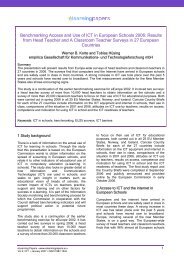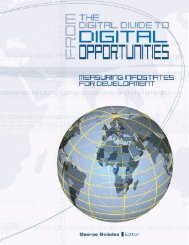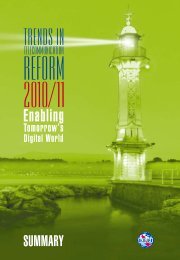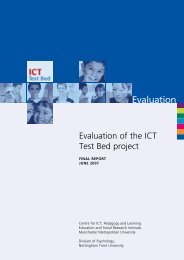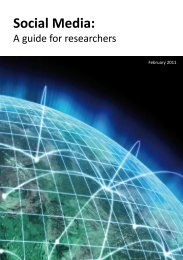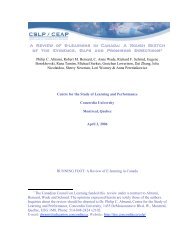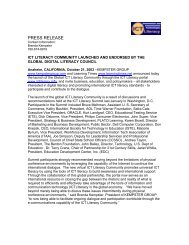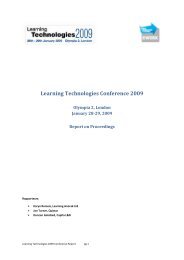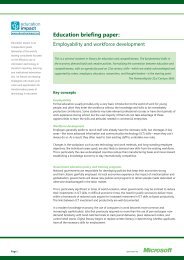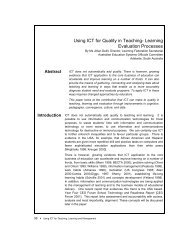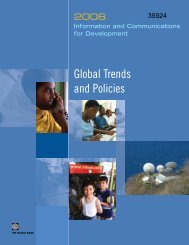147 pages pdf - ICT Digital Literacy
147 pages pdf - ICT Digital Literacy
147 pages pdf - ICT Digital Literacy
Create successful ePaper yourself
Turn your PDF publications into a flip-book with our unique Google optimized e-Paper software.
Content, Content (Not To Mention Content) … How To Best Design & Deliver It<br />
#238: The Magic Number? 15!<br />
E-learning modules should be designed so that learners can take chunks of content in no more<br />
than 15 minutes at a sitting.<br />
Eric Kugler<br />
Healthcare E-learning Collaborative<br />
#239: The Real Scoop on Practical Design<br />
The effectiveness and ultimate value – to both users and the organisation – of e-Learning will be determined by the<br />
quality of instructional design that underlies the training materials. To keep these as high as possible you should:<br />
• Set technical standards for the whole project – including lists of the software required and how it is to be set up.<br />
• Make sure that the instructional designer is fully briefed on the subject material by a subject matter expert.<br />
Making an effective multimedia programme requires – at least – a subject matter expert, an instructional<br />
designer who can translate the programme content into multimedia using your chosen interface, and a<br />
programmer who translates what the designer says into something you can see.<br />
• Reduce the training material to "bite sized chunks" for online delivery. Anything larger will call for technical<br />
(bandwidth) capability that the system does not possess.<br />
• Avoid a plethora of graphics, animations and "flashy bits." These can cause problems if plug-ins are needed at<br />
the delivery end to make these play. There are other, effective ways of making a programme visually interesting.<br />
• Keep the format of the material simple.<br />
• Ensure that part of the production process is to test the programme rigorously with groups of users with similar<br />
skills to your target audience. Note their responses and the way they use the programme. Was it relevant to their<br />
jobs? Could its content be easily assimilated into working practices? Did they find navigating through the<br />
programme easy? How long did it take them to complete the programme? Did the user control the programme or<br />
go through it linearly (from start to finish)? And, of course, did the users enjoy the learning experience?<br />
Vaughan Waller<br />
Technologies For Business & Learning<br />
#240: Lights, Camera, Action!<br />
When presenting soft skills, you can enhance the "uptake" of the information by providing scenarios that<br />
illustrate the application of the skills being presented. Tips for creating these scenarios include: 1. Use audio +<br />
stock photography for a lower tech/lower cost way to engage the learner in the scenario. 2. Gain awareness<br />
of your program or product by using employees within the company for the audio. Hold auditions! 3. Buy your<br />
own microphone & sound software and use your laptop to capture and edit the audio. 4. Don't forget diversity!<br />
Be sure the photos and voices reflect a diverse population.<br />
Allison Anderson<br />
Intel University<br />
#241: Adapt, Adjust & Accommodate For The Specific Content Style<br />
Be extremely aware of the differences in writing structure and style of presentation for the following three types of content:<br />
Reference, Performance Support and Education/Training. With much hype around "content conversion," there is a<br />
temptation to repurpose classroom or reference materials directly into e-Learning or Performance Support materials.<br />
Resist the temptation! While the information contained in the original material is invaluable and time-saving, it almost<br />
ALWAYS needs to be re-worked so that it's appropriate for the new purpose and audience. Examples? Reference<br />
writing needs to be feature, function, or topic-focused, requiring little context. Performance Support writing should be task<br />
or decision-focused with links or references to contextual information. And writing for an e-Learning course should be<br />
context-rich, conversational, and flowing along a logical progression, as though delivered by a caring, personal mentor.<br />
Rob Bohlen<br />
MaxUse LLC<br />
701 e-Learning Tips by The MASIE Center www.masie.com 49



